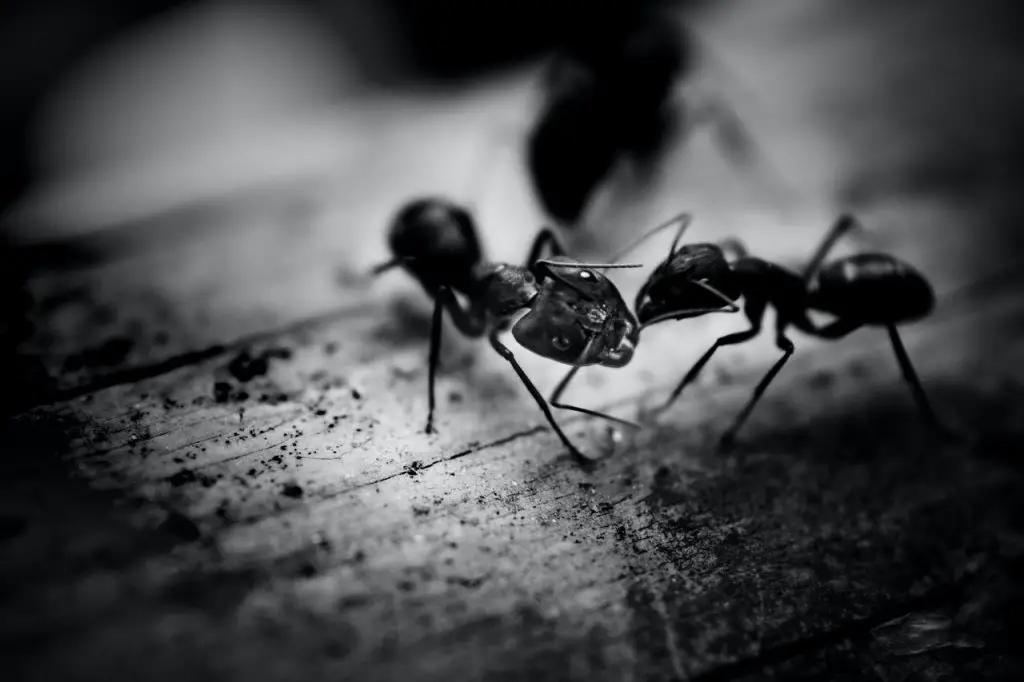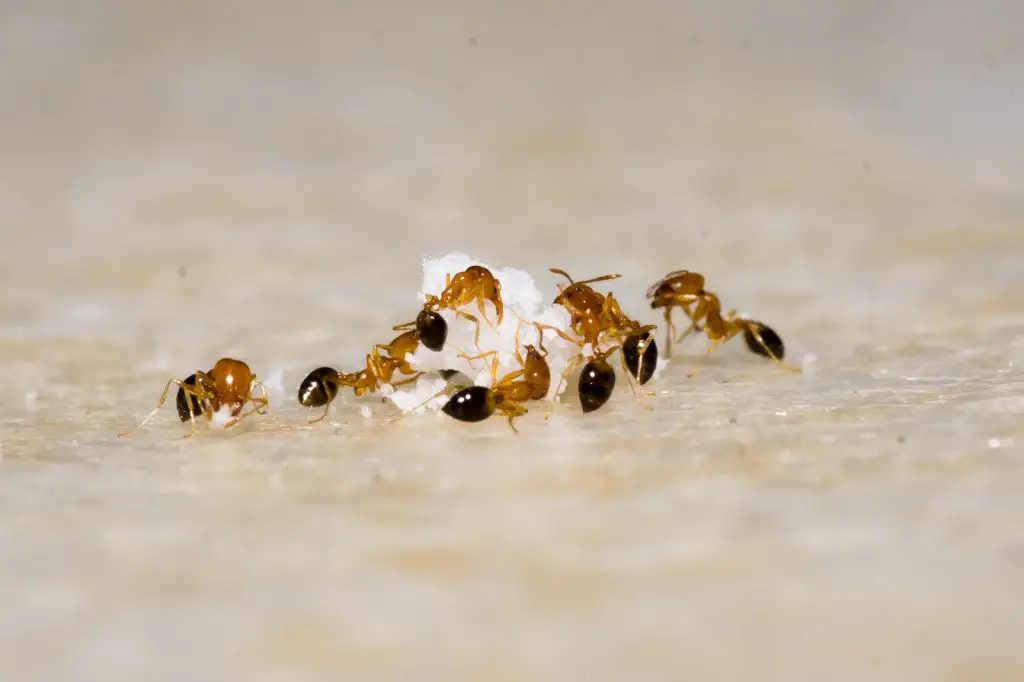Nature’s Tiny Marvels or Just a Bunch of Commuting Misfits? Unraveling the hilarious world of different Types of Ants, their Personalities, Locations, and Professions. Similarly, their Party Tricks, and how to get rid of these pesky insects!
Welcome to the enthralling realm of types of ants, where we unveil the intricate world of these industrious insects. Journey with us as we unravel the diverse cast of characters that populate the ant kingdom.
From the meticulous architects of the leafcutter ants to the aggressive defenders of the trap-jaw ants, each species showcases extraordinary adaptations and peculiar behaviors.
Grab your ant-sized popcorn and prepare for an enlightening exploration. We will dig deep into the world of different types of ants.
As we march alongside these captivating creatures, we’ll discover their intricate societies, resourceful foraging techniques, and astounding communication systems. So, let’s venture forth and unlock the secrets of the remarkable world of ants.
Types of ants
Carpenter Ants
Carpenter ants, the woodworkers of the insect world, may seem harmless at first glance, but their insatiable appetite for timber can wreak havoc on homes and structures.
These formidable pests are known for burrowing through wood, causing structural damage.
Carpenter ants exhibit a range of colors, including black, red, yellow, dark brown, light brown, and orange. In some places, these ants have red and black patterns.
These tiny insects are abundant in states like California, Oregon, Washington, Florida, Louisiana, and Massachusetts. From the Pacific Northwest to the coastal regions, these crafty pests leave their mark on homes and structures.
Stay vigilant!

5 Fascinating Facts About Carpenter Ants
- Wood Carvers: Carpenter ants skillfully tunnel through wood, creating intricate galleries without consuming it.
- Colony Size: These ants form large colonies, ranging from thousands to tens of thousands of individuals. Each one with specialized roles within its hierarchical structure.
- Winged Reproductives: Carpenter ants produce winged alates for mating flights, allowing successful females to establish new colonies.
- Diverse Diet: While primarily feeding on sugary substances, carpenter ants are omnivorous, consuming insects, meats, fats, and plant juices.
- Nesting Preferences: Rather than eating wood, carpenter ants prefer nesting in damp or decaying wood. They often establish satellite colonies, posing challenges for control.
Fire Ants
Fire ants, inhabitants of the insect world, pack a potent punch with their painful stings. Characterized by their reddish-brown coloration, Fire ants, first entered the United States in the 1930s. They entered through the port of Mobile, Alabama, likely as stowaways on cargo ships.
Since then, they have rapidly spread across southern states like Texas, Carolina, Florida, Kentucky, Louisiana, and Georgia.
Fire ants prefer open areas such as lawns, parks, and fields, constructing large and intricate underground colonies. In these open areas, fire ants create extensive underground colonies with complex tunnel systems. They fiercely defend their territory, attacking anything that disturbs their nests.
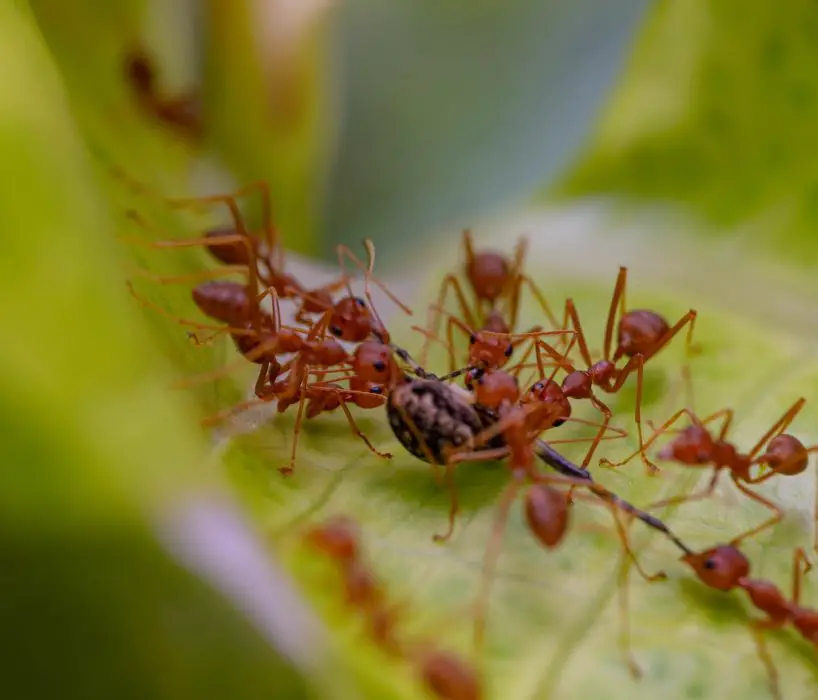
5 Fascinating Facts About Fire Ants
- Aggressive Nature: Fire ants are highly aggressive and known for their painful stings. They often attack intruders in large numbers, inflicting painful bites and stings.
- Distinct Mounds: They construct large and distinctive mounds made of soil, which can reach significant heights and provide protection for their colonies.
- Venomous Sting: Fire ants possess venomous stingers that inject potent venom. It can cause a burning sensation, itching, and the formation of pus-filled blisters.
- Electrical Nuisance: Fire ants are attracted to electrical equipment. They can cause damage by nesting inside and chewing through wiring insulation.
- Floating Colonies: When faced with flooding or heavy rainfall, fire ants display unique survival behavior by linking together and forming floating colonies, enabling them to float on water until reaching dry land.
Argentine Ants
Argentine ants, notorious invaders of urban areas, have established themselves as a formidable force in many regions across the globe.
Originating from South America, Argentine ants were first documented in Western Australia in 1941. Since then, these diminutive creatures have expanded their territories to numerous other regions worldwide, including the United States, South Africa, and various parts of Europe.
In the United States, several states such as California, Texas, Florida, and Arizona have noted infestations of Argentine ants. These states provide suitable conditions for their proliferation.
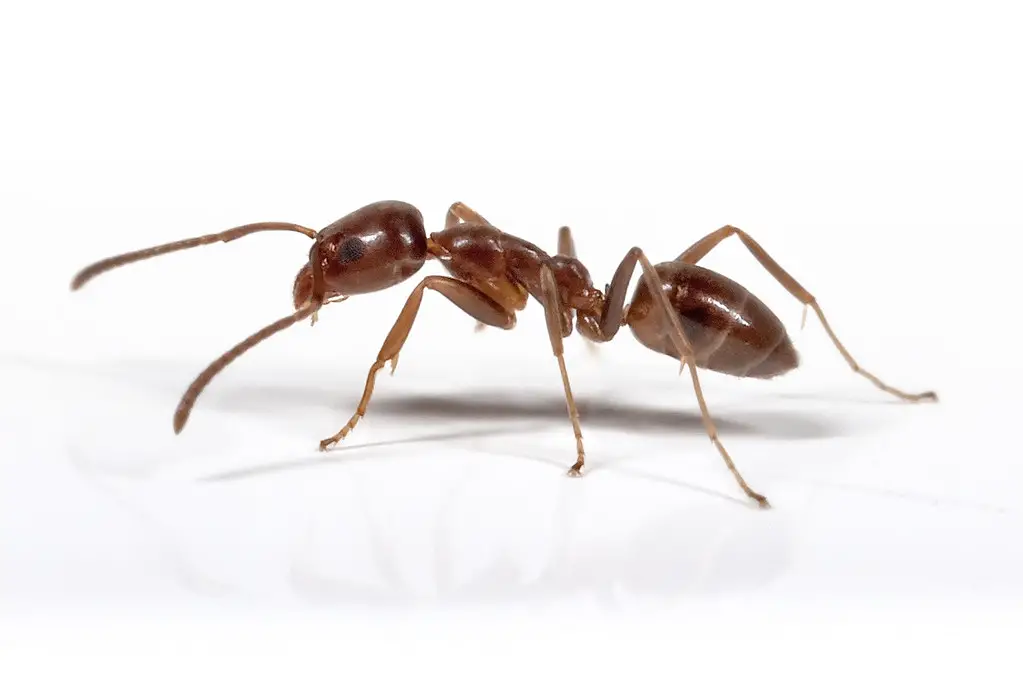
5 Fascinating Facts About Argentine Ants
- Massive Supercolonies: Argentine ants form expansive supercolonies that can stretch for miles, with interconnected nests housing millions of ants.
- Cooperative Behavior: Within supercolonies, Argentine ants exhibit remarkable cooperation and maintain peace between nests, avoiding aggressive conflicts.
- High Sugar Diet: These ants have a strong preference for sugary substances. They have a particular affinity for honeydew produced by aphids and scale insects.
- Rapid Displacement: Argentine ants aggressively displace native ant species, which leads to ecological imbalances.
- Trail Sharing: Unlike many ant species, Argentine ants readily share and utilize trails established by other colonies, allowing for efficient foraging and resource exploitation.
Crazy Ants
Crazy ants, also known as Rasberry crazy ants or Tawny crazy ants, are an invasive ant species with peculiar behavior. They are known for their polygynous nature and exhibit rapid colony growth and expansion.
This, coupled with their voracious appetites, often targeting native species, results in significant ecological impact due to increased reproduction rates and expanding colonies.
Crazy ants’ ability to establish colonies in both urban and natural environments has made them a formidable force to reckon with.
These relentless pests are found in abundance in the southern United States, particularly in Texas, Louisiana, and Florida.
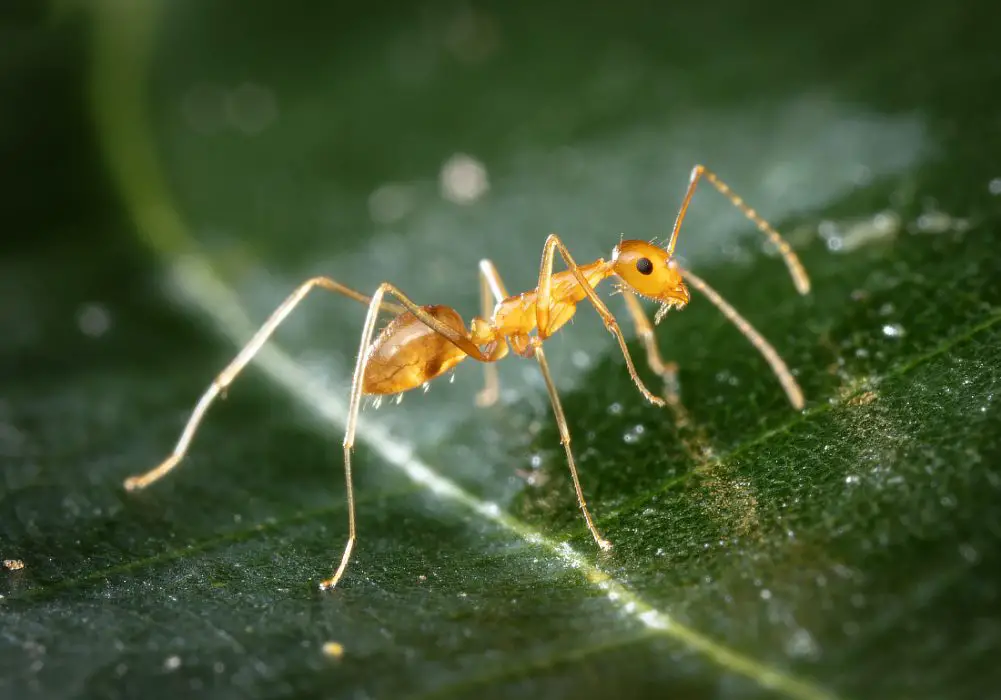
5 Fascinating Facts About Crazy Ants
- Erratic Movements: Crazy ants get their name from their distinctive, fast-paced, and erratic movements, which set them apart from other ant species.
- Multiple Queens: Unlike many ant species, crazy ants can have multiple queens in a single colony, leading to larger and more expansive colonies.
- Colony Intrusion: Crazy ants are renowned for invading and dominating the nests of other ant species, disrupting their colonies and foraging patterns.
- Chemical Defense: When threatened, crazy ants release a chemical secretion that can repel or neutralize attackers, acting as a form of defense.
- Adaptability: These ants have proven to be highly adaptable to different environments, allowing them to establish successful colonies in both natural habitats and urban areas.
Pharaoh Ants
Pharaoh ants, scientifically known as Monomorium pharaonis, are originally from tropical regions. these tiny pests have successfully expanded their presence worldwide, infiltrating homes, hospitals, and various structures.
Infamous for their resilient nature, they pose significant challenges in control efforts.
Thriving in urban areas, Pharaoh ants find particular abundance in states like New York, Florida, Pennsylvania, Michigan, Texas, and California. Their ability to adapt and persist in diverse environments has solidified their status as formidable household pests.

5 Fascinating Facts About Pharaoh Ants
- Small Size: Pharaoh ants are incredibly small, with workers measuring around 1/16th of an inch in length. It makes them difficult to spot and control.
- Multitude of Hideouts: These ants nest in a variety of places, including wall voids, electrical outlets, and even inside furniture, making them challenging to eradicate.
- Intricate Foraging Patterns: Pharaoh ants exhibit complex foraging behaviors, establishing intricate trails and utilizing pheromone communication to efficiently navigate between food sources and their nests.
- Indoor Pests: They are primarily indoor pests, infesting homes, hospitals, and buildings, particularly attracted to warm and moisture-rich areas.
- Nuisance and Health Concerns: Pharaoh ants can contaminate sterile environments, invade food storage areas, and carry pathogens, making them a nuisance and potential health hazard.
Black Garden Ants
Black garden ants, or Lasius niger, are commonly spotted in gardens and outdoor spaces. Also known as common black ants or pavement ants, they are found globally, including in North America, Europe, and Asia.
In the US, these adaptable insects thrive in states like California, Illinois, Ohio, Texas, Florida, and Michigan, flourishing in urban and rural areas alike.
In the summer months of July and August, witness the spectacle of winged males and females emerging for enchanting mating flights.
As nature’s ballet unfolds, only a handful of female survivors embark on a remarkable journey to establish new colonies, defying the odds and captivating our curiosity.

5 Fascinating Facts About Black Garden Ants
- Aphid Farming: Black Garden Ants cultivate aphids, protecting them from predators and feeding on the honeydew they produce, establishing a mutually beneficial relationship.
- Trophallaxis: Trophallaxis is the behavior of regurgitating and sharing food among colony members of Black Garden Ants. It facilitates the distribution of nutrients and strengthens social bonds.
- Elbowed Antennae: These ants possess distinct elbowed antennae, which help them navigate their environment, locate food, and communicate with other colony members.
- Foraging Abilities: These ants have impressive foraging ranges, with workers covering significant distances from their nests in search of food sources.
- Ecosystem Impact: Black Garden Ants play important roles in ecosystem dynamics, such as seed dispersal, soil aeration, and nutrient cycling, making them ecologically significant.
Bullet Ants
Bullet Ants, renowned as the insect world’s champions of the sting, their presence demands respect. These remarkable creatures don reddish-black bodies adorned with fine hairs, signaling their distinction.
Though Bullet ants are nonaggressive by nature, when provoked, their stings become relentless as they release chemicals to signal nearby ants to join the attack.
Remarkably, the bullet ant holds the record for the most painful sting among all insects, as determined by the Schmidt Pain Index. The venomous bite they deliver, often compared to the sensation of being shot, causes an excruciating experience that can persist for hours.
Originating from the rainforests of Central and South America, Bullet Ants thrive in countries like Brazil, Costa Rica, and Nicaragua.
In the United States, regions such as Florida and Texas are home to these captivating creatures, their remarkable presence leaving an indelible mark.
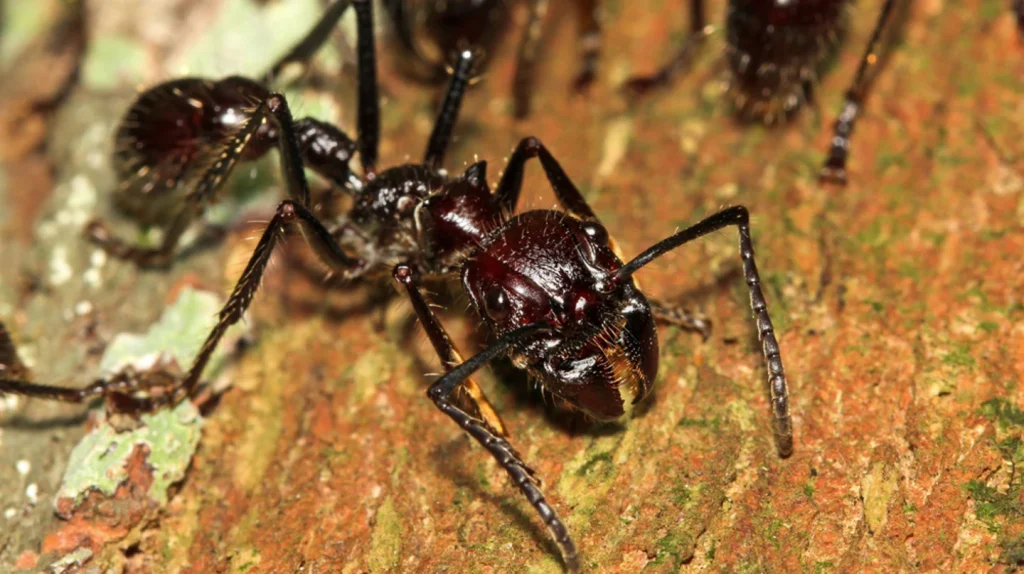
5 Fascinating Facts About Bullet Ants
- Ancient Lineage: Bullet Ants belong to the ancient ant subfamily Paraponerinae, which has existed for over 95 million years, showcasing their resilience and evolutionary success.
- Longevity and Hibernation: Bullet Ant queens have an exceptional lifespan. She lives for 10 to 20 years, while the workers have an average lifespan of 1 to 2 years. During the dry season, these ants enter a period of hibernation to conserve energy.
- Impressive Jaw Strength: Bullet Ants possess mandibles that are not only powerful but also capable of opening and closing rapidly, enabling them to grasp prey or defend themselves with precision.
- Cooperative Brood Care: Bullet Ant workers exhibit cooperative brood care, tending to the eggs, larvae, and pupae in the colony, ensuring their development and survival.
- Mating Flight Rituals: During the mating flight, male Bullet Ants engage in a unique ritual called “tandem running,” where they follow and court females in the air before mating occurs.
Odorous House Ants
Odorous House Ants, also referred to as “stink ants,” emit a pungent odor when crushed, reminiscent of rotten coconut or blue cheese. With a dark brown or black coloration, they are small in size, typically measuring around 1/8 inch (3.2 mm) in length.
Notably, they are capable of forming large colonies with multiple queens, contributing to their resilience and adaptability.
Odorous House Ants thrive in various habitats, including homes, gardens, and urban areas, where they seek out sweet or greasy food sources.
Originally from South America, they have established a strong presence in the United States, particularly in states such as Washington, California, Illinois, New York, Florida, and Texas.
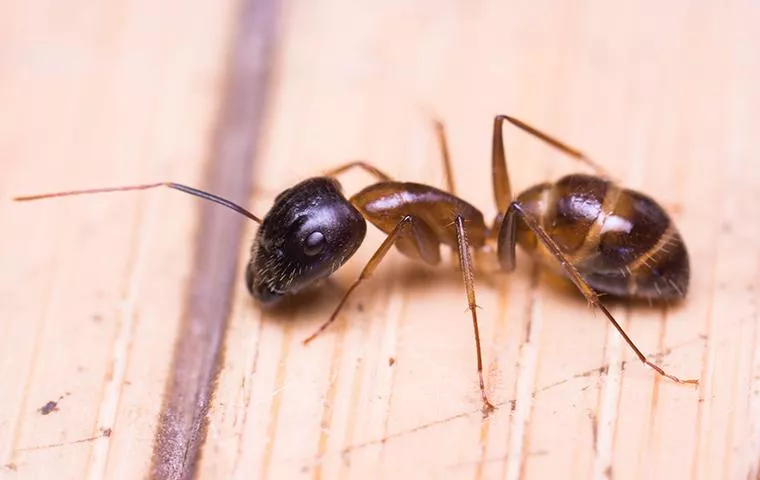
5 Fascinating Facts About Odorous House Ants
- Nesting Preferences: Odorous House Ants commonly nest near moisture sources, such as in wall voids, under sinks, or in decaying wood, displaying their affinity for damp environments.
- Wide Distribution: These ants have established a global presence. apart from the United States they are also in other parts of the world, including Europe, Asia, and Australia.
- Small Worker Variation: Odorous House Ant workers exhibit minor size variations within the same colony.
- Social Structure: Unlike some ant species, Odorous House Ant colonies typically consist of a single functional queen responsible for reproduction, accompanied by numerous workers.
- Indoor Foraging: These ants are highly adaptable to indoor environments, often foraging indoors for food sources, which can make them a common household nuisance.
Red Wood Ants
These ants, also known as Formica rufa, display a striking reddish-brown coloration that sets them apart. They are highly organized social insects, forming large colonies with specialized roles for each member.
While their sting is not as potent as some other ant species, they possess powerful mandibles used for defense and capturing prey.
Red Wood Ants thrive in forested habitats, particularly in coniferous and mixed woodlands. These remarkable ants build impressive mounds and exhibit a unique behavior known as “ant mills,” where a circular pattern of ants can form, resulting in a never-ending loop.
Originally from Europe and Asia, they have established a presence in the United States, primarily in northern regions such as Alaska, Washington, and parts of New England.

5 Fascinating Facts About Red Wood Ants
- Impressive Mound Builders: Red Wood Ants are skilled architects. They construct large mounds made of twigs, pine needles, and other organic matter, which can reach impressive heights and provide a haven for their colonies.
- Unique Communication Methods: These ants use chemical signals, vibrations, and body postures to communicate with each other, allowing for effective coordination within the colony.
- Skilled Predators: Red Wood Ants are adept hunters, preying on small insects, spiders, and even other ants, displaying their predatory nature and playing a vital role in maintaining ecosystem balance.
- Tree-Top Nesters: Some Red Wood Ant species nest in trees, constructing nests among branches or in hollows, showcasing their adaptability to different habitats within forested environments.
- Plant Mutualism: Red Wood Ants engage in mutualistic relationships with certain tree species, providing protection against herbivores while receiving sweet secretions from specialized leaf structures, enhancing their nutritional intake.
Red Imported Fire Ants
Red Imported Fire Ants, scientifically known as Solenopsis invicta, are formidable creatures with distinctive traits. These ants boast a reddish-brown coloration that sets them apart.
Known for their painful sting, they can inflict severe discomfort and allergic reactions in humans. When someone disturbs their nests, they respond swiftly by swarming out of the mound and delivering painful stings to defend their colony.
Originally from South America, these ants have established a significant presence in the United States, particularly in southern states such as Texas, Florida, Louisiana, and Georgia.

5 Fascinating Facts About Red-Imported Fire Ants
- Multiple Mounds: These ants build multiple interconnected mounds, creating extensive networks of nests that can cover large areas, allowing them to establish expansive colonies.
- Omnivorous Diet: Red Imported Fire Ants are opportunistic feeders. They consume a wide range of food sources, including insects, small animals, seeds, fruits, and even carrion.
- Water Survival Techniques: These ants have unique adaptations to survive flooding. They can form living rafts by linking together and floating on the water’s surface until they find dry land.
- Fast Colony Growth: Red Imported Fire Ant colonies grow rapidly, with a single queen capable of producing thousands of offspring, leading to the establishment of large and highly organized colonies.
- Interference Competition: These ants engage in interference competition with other ant species, outcompeting and displacing native ants by dominating resources and habitats.
Red Harvester Ants
Red Harvester Ants, scientifically known as Pogonomyrmex barbatus, are captivating creatures with intriguing attributes. These ants derive their name from their distinctive behavior of collecting and storing seeds.
Sporting a vibrant red coloration, they stand out in their arid habitats. While their sting is not as potent as some other ant species, they can deliver a painful bite when provoked.
Red Harvester Ants thrive in dry and sandy environments, commonly found in deserts, grasslands, and scrublands. Originating from North America, these ants have a strong presence in the United States.
They are in abundance in states like Arizona, Texas, New Mexico, and California.

5 Fascinating Facts About Red Harvester Ants
- Thermoregulation Experts: Res Harvester ants display remarkable thermoregulation behavior, actively adjusting their foraging patterns and mound architecture to regulate the temperature within their nests.
- Complex Social Structure: They have a complex caste system, with specialized roles for different members. Queens are responsible for reproduction, while workers undertake foraging, nest maintenance, and defense tasks.
- Intense Defense Tactics: When threatened, Red Harvester Ants exhibit aggressive defensive behavior. They bite and stings the intruders with their powerful jaws and venomous stings to protect their nests and food sources.
- Cooperative Foraging Strategies: Red Harvester Ants employ cooperative foraging, forming long foraging trails as they search for seeds and other food resources, communicating through chemical signals to guide their fellow workers.
- Ecological Engineers: Red Harvester Ants play a vital ecological role by aerating the soil and dispersing seeds as they collect and store them, contributing to plant diversity and the overall health of their surrounding ecosystems.
Silky Ants
Silky Ants, scientifically known as Formica fusca, are fascinating insects with distinct characteristics. These ants derive their name from the silky texture of their exoskeleton, which gives them a unique appearance.
Sporting a predominantly black coloration, they blend seamlessly into their surroundings.
Silky Ants possess a relatively mild sting that is not considered harmful to humans. They are highly adaptable and can thrive in various habitats, including forests, grasslands, and urban areas.
Originally from Europe, Silky Ants have successfully established populations in several regions worldwide, including the United States. States such as Maine, New Hampshire, Vermont, and New York have them in the United States.

5 Fascinating Facts About Silky Ants
- Cooperative Nesting: Silky Ants exhibit a cooperative nesting behavior, with multiple queens and workers sharing the same nest, which enhances their ability to build and maintain larger colonies.
- Silk-Producing Larvae: Silky Ant larvae have a special gland that produces silk, which they use to construct protective cocoons. This silk provides insulation and protection for developing ants.
- Social Parasitism: Some Silky Ant colonies engage in social parasitism, infiltrating and exploiting the resources of other ant species’ nests by integrating their brood and workers into the host colony.
- Thermal Regulation: Silky Ants demonstrate thermal regulation behavior, actively moving their brood and relocating their nests to adjust to changing environmental temperatures and ensure the survival of their colonies.
- Trophobiotic Relationships: Silky Ants engage in trophobiotic relationships with aphids and other sap-sucking insects. They protect these insects and harvest the sugary honeydew they produce as a valuable food source.
Ghost Ants
Ghost Ants, scientifically known as Tapinoma melanocephalum, are captivating creatures with intriguing attributes. These ants derive their name from their almost translucent appearance, giving them a ghost-like quality.
Their small size and light brown to pale yellow coloration further contribute to their ethereal presence. They are highly adaptable and can thrive in a variety of habitats, including homes, gardens, and urban environments.
Originally from Africa, Ghost Ants have successfully established populations in various regions worldwide, including the United States. In the United States, they can be found in states such as Florida, Texas, California, Hawaii, and Louisiana.

5 Fascinating Facts About Ghost Ants
- Colony Budding: Ghost Ant colonies exhibit a unique behavior known as “budding,” where a group of ants, including workers and a queen, leave the original nest to establish a new colony nearby, contributing to their rapid spread.
- Pheromone Trails: Ghost Ants rely heavily on pheromone trails to communicate and navigate their surroundings, enabling efficient foraging and ensuring colony cohesion.
- Nesting Preferences: Ghost Ants display a preference for nesting in protected indoor locations, such as wall voids, electrical outlets, and behind baseboards, which can make them challenging to eradicate.
- Rapid Colonization: Ghost Ants rapidly colonize and have a high reproductive rate, allowing them to establish large populations in a short period, posing potential challenges for pest control efforts.
- Invasive Species: In many regions around the world, including the United States, Ghost Ants are considered invasive species that can disrupt native ant populations and become problematic household pests.
Field Ants
Field ants belong to various species within the Formica genus. They are fascinating insects thriving in a variety of habitats around the world. They got their name from their preference for nesting in open fields and grassy areas.
Field ants construct large mounds, which can reach impressive heights and serve as their nests. They come in various colors, including black, brown, and red, with some species displaying a combination of these hues.
While field ants possess stingers, their sting is generally mild and not considered harmful to humans.
These versatile ants exist in various parts of the United States, including states like Washington, Oregon, California, New York, and Texas.
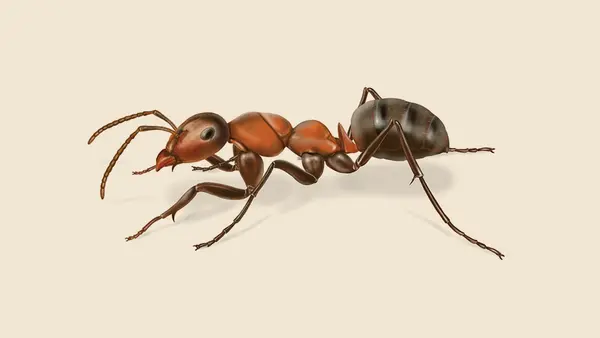
5 Fascinating Facts About Field Ants
- Impressive Mound Builders: Field ants construct intricate and sizable mounds that can reach several feet in height, providing shelter and protection for their colonies.
- Farming Aphids: Some species of Field Ants engage in a fascinating behavior called aphid farming. They cultivate and protect aphids, using them as a food source by milking their sugary honeydew secretions.
- Resourceful Foragers: Field Ants are resourceful foragers, known to cover vast distances in search of food sources. They have a diverse diet that includes nectar, small insects, seeds, and even honeydew from aphids.
- Territorial Defense: Field Ants are highly territorial and will fiercely defend their nests and foraging areas. They employ both chemical signals and physical aggression to deter intruders and protect their resources.
- Environmental Adaptability: Field Ants are adaptable to various habitats, including meadows, forests, and grasslands. Their ability to thrive in diverse environments makes them a successful and widespread genus around the world.
Allegheny Mound Ants
Allegheny mound ants, scientifically known as Formica exsectoides, are intriguing insects with distinctive characteristics. The ants earn their name after building unique mounds, which can reach impressive heights and extend several feet in diameter.
Known for their reddish-brown coloration, Allegheny mound ants display an impressive level of coordination and organization within their colonies.
One fascinating behavior of these ants is their attempt to eliminate any vegetation around the mound. They accomplish this by biting the plant and depositing formic acid into the wound. It is a chemical substance that acts as a herbicide and prevents the growth of vegetation near their mound.
Allegheny mound ants, originally native to the eastern United States, inhabit states such as Pennsylvania, West Virginia, Ohio, and Maryland.

5 Fascinating Facts About Allegheny Mound Ants
- Superorganism Architects: Allegheny mound ants are exceptional architects, collectively building intricate mound structures. These mounds consist of interconnected chambers and tunnels, providing a complex and organized living space.
- Mound Thermoregulation: These ants exhibit sophisticated mound thermoregulation techniques. They actively adjust the mound’s shape and ventilation to regulate internal temperature and humidity.
- Unique Mound Entrances: Allegheny mound ants possess distinct multiple entrances to their mounds, which act as pathways for foraging workers and allow efficient movement in and out of the colony.
- Defense Strategies: When threatened, these ants showcase impressive defensive behaviors. They will aggressively defend their colony, utilizing their strong jaws and formic acid secretions to deter intruders and protect their nest and resources.
- Seasonal Activity Patterns: Allegheny mound ants exhibit distinct seasonal activity patterns. During colder months, the colony becomes less active, with ants retreating deeper into their mound for warmth and protection.
Grease Ants
Grease ants, scientifically known as Solenopsis molesta, are fascinating insect species that have adapted to thrive in various habitats. These tiny creatures, also known as thief ants, are natural robbers in the ant kingdom.
They exhibit a unique behavior of establishing their nests near other ant colonies, which they frequently raid for rich protein sources, particularly developing ant larvae.
These tiny ants are typically dark brown or black in color and form small, inconspicuous mounds as their nesting sites. They exhibit high adaptability and populate various regions throughout the United States.
Grease ants, originally from North America, have expanded their range and now scientists consider them a global species.
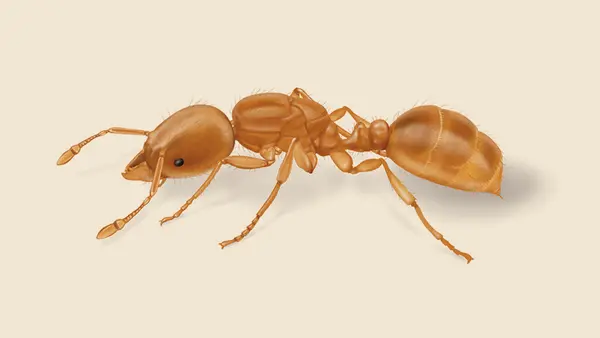
5 Fascinating Facts About Grease Ants
- Multicolored Workers: Grease ants exhibit a unique trait where their workers come in various colors, ranging from light yellow to dark brown, making them visually diverse within their own colony.
- Stingless Warriors: Unlike some ant species, Grease ants lack a stinger. They rely on their strong mandibles for defense and capturing prey. They skillfully fight and hold their ground against larger intruders.
- Quick Breeding Cycle: Grease ants have a rapid breeding cycle, with queens capable of producing multiple generations in a single year. This allows for swift colony growth and the ability to establish new nests in different locations.
- Resourceful Nests: Grease ants use various materials such as soil, twigs, leaf fragments, and even small pebbles for nest construction. This creative approach ensures a structurally sound and protected home for the colony.
- Pheromone Trails: To communicate and navigate, Grease ants rely heavily on pheromone trails. They lay down chemical markers, guiding other members of the colony to food sources and enabling effective coordination in their foraging activities.
Pavement Ants
Pavement ants, scientifically known as Tetramorium caespitum, are tiny yet tenacious insects that have adapted to thrive in urban environments. These ants get their name from their affinity for nesting in pavement cracks, sidewalks, and driveways.
Pavement ants are typically dark brown to black in color, with workers measuring around 2-4 mm in length. While not known for a strong sting, pavement ants can bite if they feel threatened. They are social insects that live in colonies, constructing small mounds or nests near concrete structures.
Originally native to Europe, pavement ants have successfully spread to various parts of the United States. States such as New York, Pennsylvania, Ohio, Illinois, and Massachusetts commonly host them.

5 Fascinating Facts About Pavement Ants
- Impressive Nest Architecture: These ants construct intricate networks of tunnels and chambers within their underground nests. It provides organized space for brood rearing, food storage, and protection.
- Cooperative Brood Care: Pavement ant workers work together to care for and protect the developing brood, ensuring their survival and growth within the colony.
- Antennal Drumming Communication: Pavement ants use a unique form of communication called antennal drumming, where they tap their antennae on various surfaces to convey information to other ants.
- Colony Fragmentation: When pavement ant colonies become too large, they can undergo a process called colony fragmentation, where subgroups break off to form new satellite colonies.
- Intense rivalry with other ant species: Pavement ants engage in territorial battles with other ant species, competing for resources and defending their territory against invaders.
Leafcutter Ants
Leafcutter Ants, which are scientifically known as Atta and Acromyrmex, belong to the tribe Attini and are renowned for their remarkable leaf-cutting behavior.
These ants showcase remarkable characteristics, such as their strong mandibles and impressive strength, allowing them to effortlessly cut through leaves. They use the collected leaves to cultivate a special fungus that serves as their primary food source.
Leafcutter Ants primarily inhabit the tropical regions of Central and South America, including countries like Brazil, Colombia, and Costa Rica.Within the United States, these ants are most commonly found in states like Texas, Florida, and Louisiana, where suitable environmental conditions support their thriving populations.

5 Fascinating Facts About Leafcutter Ants
- Ecological Farmers: Leafcutter Ants are exceptional agriculturalists of the insect world. They collect and cut leaves, creating leaf fragments that they carry back to their nests. These leaves serve a specific type of fungus as a food source.
- Super Strength: Despite their small size, Leafcutter Ants possess incredible strength. They can carry leaf fragments that are several times larger and heavier than themselves.
- Sustainable Fungus Cultivation: These ants cultivate a highly specialized fungus that can only survive within the controlled environment of the ant colony. The ants actively maintain and protect the fungus from pests and molds as a reliable food source.
- Leafcutter Highways: Leafcutter Ants create distinct trails or highways along which they transport their leaf fragments. These highways can extend for several meters and are often clearly visible on the forest floor.
- Underground Cities: Leafcutter Ant colonies are massive and can contain millions of individuals. These colonies are intricate underground cities, consisting of vast networks of interconnected tunnels and chambers that house different castes.
Honeypot Ants
Honeypot Ants, also known as repletes or honey ants, are intriguing insects that exhibit specialized behavior and unique physical adaptation within certain ant species.
As their name suggests, Honeypot Ants have the ability to store and regurgitate liquid food, such as nectar or honeydew, to nourish other members of their colony during times of scarcity. The storage capacity of these ants can be quite remarkable, with their abdomens expanding to the size of small grapes or even larger.
Honeypot Ants primarily inhabit arid and semi-arid regions, such as deserts and dry grasslands. These creatures can be found in various parts of the world, including regions of Africa, Australia, and the Americas. They have been observed in different states within the United States, such as Arizona, New Mexico, and Texas.

5 Fascinating Facts About Honeypot Ants
- Unique Morphology: Honeypot Ants have distinct physical adaptations, including an expandable gaster (abdomen) that can stretch to accommodate stored food. This specialized feature allows them to become living food reservoirs within the colony.
- Varied Roles: Some repletes may serve as living incubators for developing larvae, while others act as food distributors, regurgitating stored liquid food for the nourishment of their fellow ants.
- Dietary Adaptations: Honeypot Ants have evolved specific physiological adaptations that enable them to process and digest liquid food more effectively than other ant species. These adaptations ensure efficient utilization of the stored resources.
- Seasonal Survival Strategy: During periods of food abundance, Honeypot Ant colonies prioritize food storage by increasing the number and size of repletes.
- Unique Communication: Honeypot Ants utilize specialized chemical signals to communicate information about food availability within the colony. These chemical signals help coordinate the distribution and allocation of stored food resources.
White-footed Ants
White-footed Ants, scientifically known as Technomyrmex albipes, are intriguing insects with unique characteristics. These ants derive their name from the distinctive white coloration on their feet. They are relatively small in size, typically measuring around 2 to 3 millimeters in length.
White-footed ants earn recognition for their rapid movements and their ability to construct extensive underground colonies with interconnected tunnels and chambers.
They are native to regions of Asia, including countries like India and Malaysia. However, due to human activity and accidental introductions, they have established populations in various parts of the world.
These ants can be found in Southeastern states of the United States, such as Florida, Georgia, and Louisiana.

5 Fascinating Facts About White-footed Ants
- Herbivorous Diet: These ants uniquely prefer honeydew, which is a sweet secretion produced by aphids and other plant-sucking insects.
- Dispersal by Flight: White-footed Ants have the ability to disperse and establish new colonies through nuptial flights. During this process, winged males and females mate, and the fertilized queens go on to establish new colonies in suitable locations.
- Nomadic Behavior: White-footed Ants exhibit nomadic behavior, frequently migrating and relocating their nests in response to changing environmental conditions or resource availability.
- Displacement of Native Species: In some regions, White-footed Ants have become invasive and have displaced native ant species. Their rapid reproduction, efficient foraging, and adaptability contribute to their success in colonizing new habitats.
- Communication through Chemical Signals: White-footed Ants communicate primarily through the use of chemical signals called pheromones.
Pyramid Ants
Pyramid Ants, scientifically known as Dorymyrmex pyramicus, are intriguing insects distinguished by the pyramid-shaped structure on their thorax. These Ants have Red or reddish-black heads, and thorax, with black abdomen.
They are relatively small in size, measuring about 2 to 5 millimeters in length. While Pyramid Ants possess a stinger, their sting is generally mild, causing minimal discomfort to humans.
Pyramid Ants are native to various regions across North and South America, including countries such as the United States, Mexico, and Brazil. These ants can be found in states like Texas, Arizona, and California within the United States.
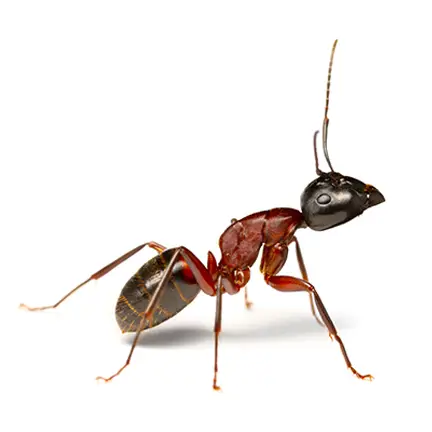
5 Fascinating Facts About Pyramid Ants
- Mandible Specialization: Pyramid Ants possess mandibles uniquely adapted for capturing and subduing their prey. These specialized mouthparts allow them to efficiently secure and manipulate food sources.
- Complex Communication: Pyramid Ants utilize a sophisticated system of chemical signals, including pheromones, to communicate with colony members to coordinate foraging, defense, and identifying nest mates.
- Thermal Regulation: Pyramid Ant colonies employ thermoregulatory behaviors to maintain suitable temperatures within their nests. They may relocate the brood or adjust their mound structure to optimize heat retention or dissipation.
- Seed Dispersers: Some species of Pyramid ants play a crucial role in seed dispersal. By collecting and moving seeds, they contribute to plant diversity and the distribution of vegetation in their habitats.
- Interspecies Interactions: Pyramid Ants engage in complex interactions, both aggressive and cooperative, with other ant species. These interactions influence community dynamics and resource partitioning within their ecosystems.
Harvester Ants
Harvester Ants, also known as Pogonomyrmex spp., are fascinating insects known for their distinct mounds and industrious foraging habits. These Ants display variations in coloration, ranging from reddish-brown to black.
They are generally medium to large in size, with workers measuring around 5 to 15 millimeters in length.
One interesting aspect of Harvester Ants is their harvesting behavior. They are diligent foragers, collecting seeds and plant material which they store within their nests as a food source. This behavior contributes to the dispersal of seeds and aids in plant regeneration.
Various regions across North and South America, including countries like the United States, Mexico, and Argentina, are home to Harvester Ants.
Within the United States, these ants are particularly abundant in states such as Texas, Arizona, and California.
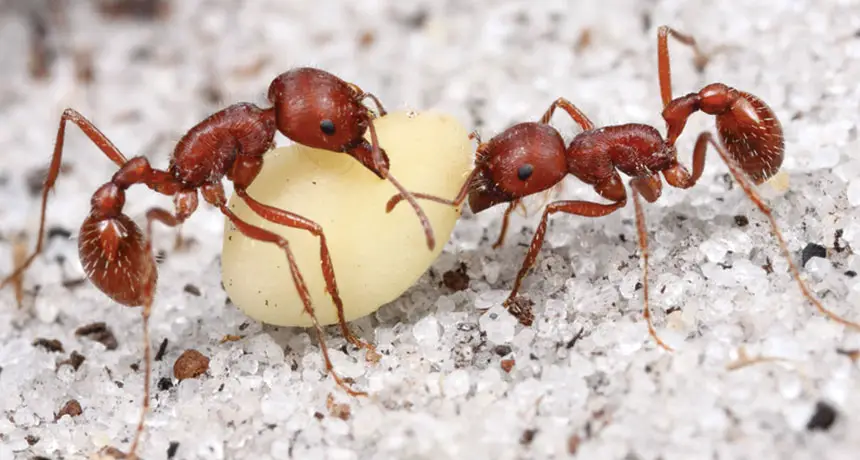
5 Fascinating Facts About Harvester Ants
- Thermoregulation Experts: Harvester Ants exhibit remarkable thermoregulation abilities. They actively control the temperature within their nests by adjusting mound construction, ensuring optimal conditions for brood development and colony survival.
- Granivorous Diet: Harvester Ants primarily feed on seeds, but they also consume nectar, insects, and other small invertebrates. Their granivorous diet is essential for their nutrition and energy needs.
- Lifespan and Reproduction: Harvester Ant queens can live for several years, producing numerous offspring during their lifetime. Mating flights occur when winged males and females emerge to mate.
- Communication through Vibrations: Harvester Ants communicate using a unique method called stridulation, where they produce vibrations by rubbing body parts to convey messages to other ants in the colony.
- Solitary Foraging: Unlike some other ant species, Harvester Ants often forage individually rather than in large groups. This solitary foraging behavior allows them to explore a wider area in search of food resources.
Acrobat Ants
Acrobat Ants, scientifically known as Crematogaster spp., derive their name from their distinctive ability to raise their abdomen above their head, resembling a contortionist or acrobat.
These Ants display variations in coloration, ranging from light brown to dark brown or black. They are generally small to medium-sized ants, with workers measuring around 3 to 6 millimeters in length.
Acrobat Ants, known for their arboreal nature, excel in climbing and frequently set up nests in trees or inside the walls of buildings. They utilize their specialized hooked claws and adhesive pads on their feet to navigate vertical surfaces.
While Acrobat Ants are capable of stinging, their stings are typically mild, causing temporary discomfort for humans.
You can find Acrobat Ants in numerous regions worldwide such as North America, Europe, Africa, and Asia. Within the United States, their presence extends to states like Texas, Florida, California, and New York.
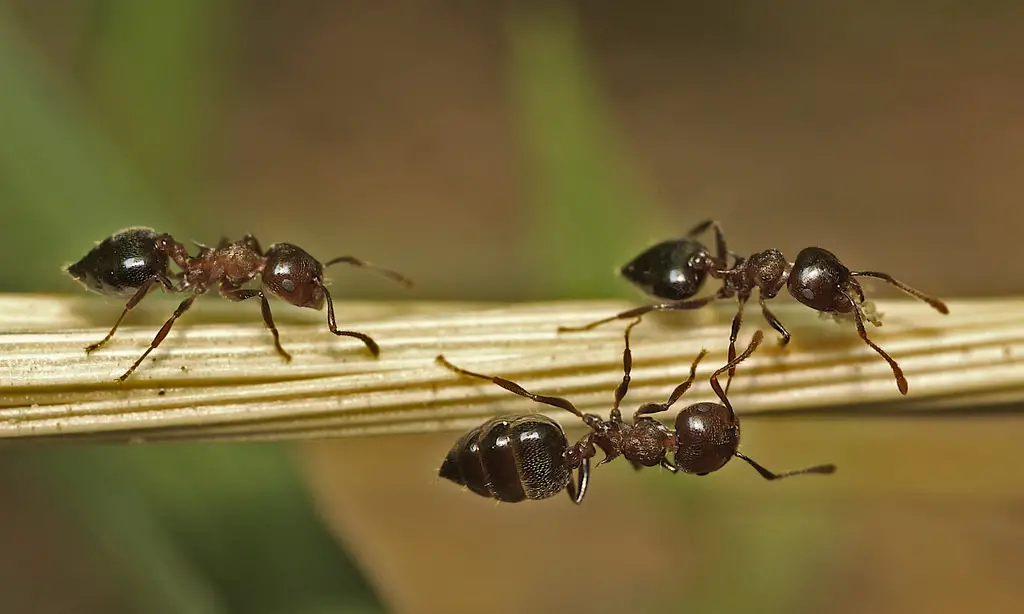
5 Fascinating Facts About Acrobat Ants
- Gravity-Defying Behavior: Acrobat Ants possess a unique ability to raise their abdomen above their head, an acrobatic behavior called “gaster flagging.” These ants use this behavior for communication, defense, and to warn off potential threats.
- Tree-Dwelling Specialists: Acrobat Ants, as skilled climbers, are experts in setting up nests in trees. They utilize their nimble legs, hooked claws, and adhesive pads to navigate and cling to vertical surfaces.
- Citronella-like Odor: When disturbed, some species of Acrobat Ants emit a citronella-like odor as a defensive mechanism. This odor acts as a deterrent, warding off potential predators or intruders.
- Unique Defensive Behavior: When threatened, Acrobat Ants exhibit distinctive defensive behaviors. They may tilt their head backward, open their mandibles, and emit warning vibrations in their defense.
- Interactions with Honeydew-Producing Insects: Acrobat Ants engage in mutualistic relationships with honeydew-producing insects, such as aphids or scale insects. They tend these insects, providing protection in exchange for the sweet honeydew.
Army Ants
Eciton spp., scientifically recognized as Army Ants, captivates us with their remarkably organized and ceaseless foraging behaviors. Their coordinated hunting strategies often earn them the nickname “Legionary Ants”.
These tiny creatures exhibit variations in coloration, typically ranging from reddish-brown to black. They are medium to large in size, with workers measuring around 5 to 15 millimeters in length.
Army Ants are voracious predators and move in large swarms, known as “armies,” in search of prey. Their prey includes a vast array of invertebrates such as insects, spiders, and at times, small vertebrates.
Their habitat spans tropical and subtropical regions, most notably in Central and South America, Africa, and certain parts of Asia. In the United States, thriving populations of Army Ants can be found in suitable habitats within states like Texas, Arizona, and Florida.

5 Fascinating Facts About Army Ants
- Nomadic Lifestyle: Army Ants have a nomadic lifestyle, constantly on the move in search of food. They do not construct permanent nests, instead establishing temporary bivouacs where they rest and care for their brood.
- Swarm Intelligence: Army Ants exhibit remarkable swarm intelligence. They can adjust their foraging routes, optimize prey capture, and quickly adapt to changing environmental conditions.
- Complex Division of Labor: Army Ant colonies have a complex division of labor. Various castes, such as soldiers, workers, and reproductive individuals, perform different tasks, ensuring the efficient functioning of the colony.
- Raiding Strategies: Army Ants employ sophisticated raiding strategies. They form wide foraging fronts, moving in a coordinated manner, comprised of insects, spiders, small vertebrates, and other arthropods.
- Temporary Bridge Formation: When encountering obstacles, such as gaps or water bodies, Army Ants can link their bodies together to form temporary living bridges. This enables the entire colony to traverse and bypass obstacles efficiently.
Short-horned Meadow Ants
Short-horned Meadow Ants, scientifically known as Lasius brevicornis, are intriguing insects commonly found in meadows and grassy habitats. People also refer to them as “Field Ants” because they prefer to nest in certain locations.
These tiny insects display variations in coloration, with darker heads and a light brown, orange, and yellowish pattern in their gaster. These medium-sized ants have workers that measure around 4 to 8 millimeters in length.
Short-horned Meadow Ants are primarily herbivorous, feeding on plant sap, nectar, and honeydew produced by aphids and other sap-sucking insects. They typically scavenge for small insects and carrion.
Short-horned Meadow Ants have a wide distribution across North America, Europe, and Asia. In the United States, places like California, Colorado, and Illinois support their abundant populations due to suitable grassland habitats.
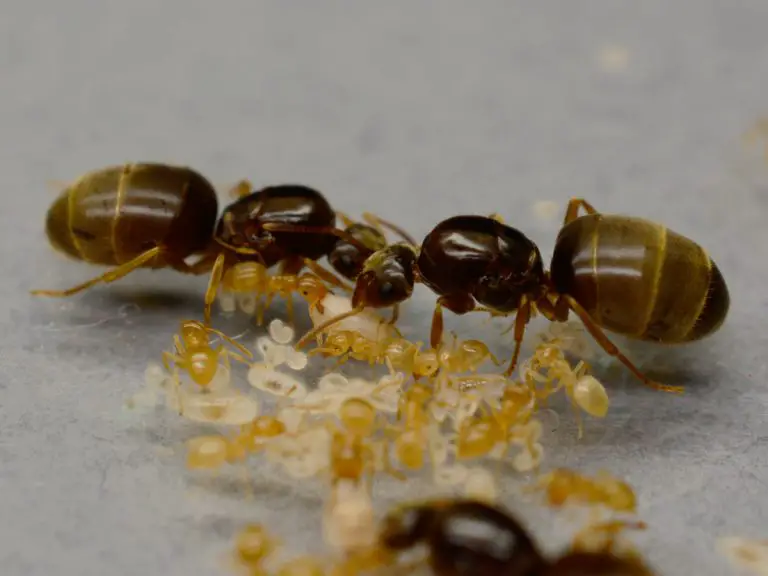
5 Fascinating Facts About Shor-horned Meadow Ants
- Nesting Preferences: Short-horned Meadow Ants prefer nesting in open grassy areas, such as meadows and fields. They construct characteristic dome-shaped mounds made from soil particles and plant debris.
- Cooperative Brood Care: Workers in Short-horned Meadow Ant colonies engage in cooperative brood care, attending to the eggs, larvae, and pupae. They ensure the development and well-being of the brood.
- Intensive Foraging Activities: These ants are highly active foragers, often covering large areas in search of food resources. They exploit a diverse range of food sources, including nectar, plant secretions, small insects, and other organic matter.
- Aggressive Defense Strategies: When their nest or colony is threatened, these ants display aggressive defensive behavior. They can deliver painful bites and spray formic acid, a defensive chemical, to deter predators or intruders.
- Seasonal Behavioral Adaptations: Short-horned Meadow Ants exhibit seasonal adaptations in their behavior. During colder months or unfavorable conditions, they may reduce foraging activities and retreat deeper into their nest to conserve energy.
Rover Ants
Rover Ants, scientifically known as Brachymyrmex patagonicus, are small and adaptable ant species found worldwide. These ants measure around 2 to 3 millimeters in length and display various colors, including shades of brown, black, and yellow.
Rover Ants are highly active foragers, constantly searching for sweet substances such as nectar and honeydew. They establish small nests beneath rocks, logs, or leaf litter, with colonies ranging from a few hundred to a few thousand individuals.
Originally, Rover Ants can be found in regions across North America, South America, Europe, and Asia. In the United States, they are particularly abundant in states such as Texas, Florida, and California, where their adaptable nature allows them to thrive in diverse habitats.

5 Fascinating Facts About Rover Ants
- Nomadic Behavior: Some Rover Ant species exhibit a nomadic lifestyle, constantly relocating their nests in response to changes in resource availability or environmental conditions.
- Multiple Queens: Rover Ant colonies may have multiple queens, contributing to the reproductive success and stability of the colony. This reproductive flexibility enhances their ability to establish and expand their populations.
- Intricate Communication: Rover Ants communicate through chemical signals called pheromones, which help coordinate foraging activities, mark trails, and recognize nestmates.
- Caring for Aphids: Rover Ant species engage in mutualistic relationships with aphids. They protect the aphids and consume their honeydew secretions, while the aphids benefit from the ants’ defense against predators.
- Subtle Nest Entrances: Rover Ants often have inconspicuous nest entrances, making them difficult for predators to locate. These small openings provide protection and help maintain the security of the colony.
Graceful Twig Ants
Graceful Twig Ants, scientifically known as Pseudomyrmex gracilis, are fascinating creatures that mimic the appearance of twigs, allowing them to blend seamlessly into their arboreal habitats. People often refer to them as slender twig ants, elongated twig ants, Mexican twig ants, or graceful twig ants.
These ants display various shades of brown, resembling the color of tree branches. They are small in size, measuring around 4 to 6 millimeters in length.
Graceful Twig Ants exhibit arboreal behaviors, often found nesting in tree cavities or hollow twigs. They are highly territorial and defend their nests fiercely against intruders.
They maintain a unique relationship with acacia trees, providing protection against herbivores, and in return, they receive food and shelter.
You can primarily find Graceful Twig Ants in tropical regions, including Central and South America. In the United States, observers have reported them in states such as Texas, Florida, and Arizona.

5 Fascinating Facts About Graceful Twig Ants
- Perfect Camouflage: Graceful Twig Ants have perfected the art of camouflage by resembling twigs, allowing them to blend seamlessly into their arboreal surroundings and avoid detection by predators.
- Agile and Nimble: Despite their small size, Graceful Twig Ants are incredibly agile and nimble climbers. They navigate tree branches and foliage with ease, utilizing their specialized leg adaptations for efficient movement.
- Specialized Mandibles: These ants possess mandibles that are uniquely adapted for handling delicate plant materials. It enables them to gather and manipulate leaves and other organic matter for nest construction.
- Intense Nest Defense: Graceful Twig Ants are highly protective of their nests. When threatened, they exhibit aggressive behaviors, using their sharp mandibles and potent venom to deter potential intruders.
- Complex Communication: These ants communicate through a combination of chemical signals, such as pheromones, and tactile interactions. It helps coordinate foraging activities, defend the colony, and maintain social cohesion.
Northern Fungus-Farming Ant
The Northern Fungus-Farming Ant, scientifically known as Atta texana, is a fascinating species renowned for its unique farming behavior. These ants have a distinct reddish-brown coloration and exhibit a robust size, with workers measuring around 6 to 8 millimeters in length.
Northern Fungus-Farming Ants cultivate a specialized fungus as their primary food source. They meticulously tend to the fungus within their elaborate underground nests, ensuring its growth and nutritional quality.
Originally, the Northern Fungus-Farming Ants can be found in parts of the southern United States, particularly in Texas, Oklahoma, and Louisiana. In these states, their abundance is supported by the warm and humid climate that favors their foraging and farming activities.

5 Fascinating Facts About Northern Fungus-Farming Ants
- Leaf-Cutting Behavior: Northern Fungus-Farming Ants ants exhibit leaf-cutting behavior, where they cut and carry leaf fragments back to their nests. The leaves serve as the substrate for growing their fungus, providing essential nutrients for its growth.
- Fungus Mutualism: The ants have a mutualistic relationship with their cultivated fungus. The ants provide nourishment and protection to the fungus, while the fungus provides the ants with a vital food source.
- Decentralized Fungus Farming: These ants practice decentralized farming. Each nest contains multiple fungus gardens, allowing for a more distributed and resilient food production system.
- Nest Architecture: The ants construct extensive underground nests with intricate tunnel systems and chambers. These nests provide suitable conditions for the growth and maintenance of their fungus gardens.
- Symbiotic Relationships: Northern Fungus-Farming Ants have symbiotic associations with certain bacteria and actinomycetes. These microorganisms help protect the ants and their fungus from pathogens.
Longhorn Crazy Ants
Longhorn Crazy Ants, scientifically known as Paratrechina longicornis, are intriguing ant species renowned for their erratic and fast-paced movements. These ants get their name from their long, slender antennae.
People in many regions refer to these tiny insects as Black Crazy Ants.
Longhorn Crazy Ants display a reddish-brown coloration and measure approximately 2 to 3 millimeters in length. They exhibit a wide range of behaviors, including rapid and erratic movements that resemble a sense of “craziness.”
Originally from Southeast Asia, these ants have spread to various parts of the world, including the United States. These ants inhabit states such as Texas, Florida, and Louisiana in the US, thriving in warm and humid environments.

5 Fascinating Facts About Longhorn Crazy Ants
- Aggressive Interactions: Longhorn Crazy Ants behave aggressively, readily engaging in territorial disputes and initiating aggressive interactions with other ant species. They can quickly overwhelm and displace native ant colonies.
- Rapid Reproduction: These ants have a high reproductive rate, allowing their colonies to grow quickly and expand their territories. This contributes to their ability to dominate new environments.
- Invasive Species: Longhorn Crazy Ants invade many parts of the world, including the United States, establishing large populations and out-competing native ant species.
- No Defined Trails: Unlike many other ant species, Longhorn Crazy Ants do not rely on well-defined trails to navigate. Instead, they explore their surroundings, which contributes to their unpredictable movement patterns.
- Electrical Attraction: Observations show that Longhorn Crazy Ants exhibit a peculiar attraction to electrical equipment and wiring. They can cause disruptions and damage by nesting in electrical boxes and short-circuiting systems.
Coastal Brown Ants
Coastal Brown Ants, also known as Pheidole megacephala, are fascinating ant species found in coastal regions around the world. These ants are commonly referred to as Big-headed Ants due to their distinctively large heads in proportion to their body size.
Coastal Brown Ants typically display a reddish-brown coloration and measure around 2 to 3 millimeters in length. They exhibit diverse behaviors, including trail formation, foraging, and intricate social structures within their colonies.
Originally from Africa, Coastal Brown Ants have become widely distributed across the globe, including in the United States. In the US, they can be found in coastal regions of states such as Florida, California, and Texas.
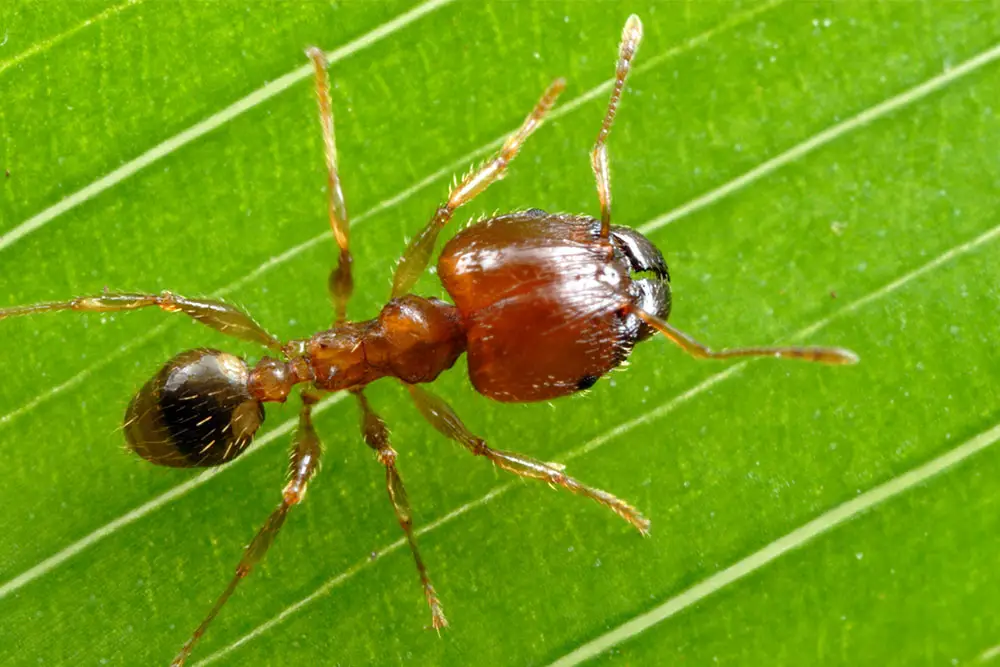
5 Fascinating Facts About Coastal Brown Ants
- Supercolonies: Coastal Brown Ants are known for forming extensive supercolonies, over large areas. It consists of interconnected nests for cooperative foraging and resource sharing among the ant populations.
- Polymorphic Workers: These Ants exhibit polymorphism, meaning they have different sizes of workers for specialized tasks, with larger workers defending the colony and smaller workers engaging in foraging and other duties.
- Aggressive Defense: Coastal Brown Ants are highly aggressive when defending their nests. They possess strong mandibles and can deliver painful bites when threatened, often attacking in large numbers to overwhelm intruders.
- Omnivorous Diet: These ants are opportunistic feeders and have an omnivorous diet. They consume a wide range of food sources, including insects, small invertebrates, plant nectar, seeds, and even human food scraps.
- Invasive Species: Coastal Brown Ants are considered invasive in many parts of the world. They have been introduced to various regions, disrupting local ecosystems and out-competing native ant species.
Sugar Ants
Sugar Ants, also known as Camponotus consobrinus, are fascinating ant species that are attracted to sugary substances. These ants get their common name from their affinity for sugar and their habit of foraging for sweet food sources.
Sugar Ants display a range of colors, including black, brown, or reddish-brown, depending on the species and individual worker variations. They are known for their larger size compared to other ant species, with workers measuring around 5 to 15 millimeters in length.
These ants are primarily found in Australia, where they are native. In the United States, sugar ants can be found in certain regions, including the Pacific Northwest and parts of California.

5 Fascinating Facts About Sugar Ants
- Powerful Mandibles: Sugar Ants have strong mandibles that allow them to bite and carry food and construct their nests. Their mandibles are capable of delivering a painful bite if threatened or disturbed.
- Foraging Behavior: These ants establish foraging trails to efficiently locate and transport sweet food sources, including nectar, honeydew produced by aphids, and sugary substances back to their nests.
- Nesting Habits: Sugar Ants typically nest in soil or wood, often creating elaborate chambers and galleries. They can also build their nests in wall voids or other secluded spaces within buildings.
- Trophallaxis: Sugar Ants engage in trophallaxis, a behavior where they exchange food and liquids with colony members through regurgitation.
- Pheromone Communication: These ants utilize chemical signals called pheromones to communicate with each other. Pheromones help guide foragers to food sources, mark trails, and convey alarm or danger signals.
Giant African Stinck Ants
Giant African Stink Ants, scientifically known as Paltothyreus tarsatus, are intriguing ant species native to sub-Saharan Africa. These ants are commonly referred to as Stink Ants due to the strong, unpleasant odor they emit when disturbed or threatened.
Giant African Stink Ants are characterized by their large size, measuring around 15 to 20 millimeters in length. They have a dark brown or black coloration and possess powerful jaws.
These ants primarily inhabit tropical regions of Africa, including countries such as Cameroon, Nigeria, and the Democratic Republic of Congo. Currently, there are no established populations of Giant African Stink Ants in the United States.

5 Fascinating Facts About Giant African Stinck Ants
- Defensive Odor: Giant African Stink Ants are notorious for their strong and pungent odor, which they release as a defense mechanism when threatened.
- Powerful Jaws: These ants possess strong jaws that they use to defend themselves and capture prey. Their mandibles are adapted for cutting and crushing, enabling them to handle larger food items.
- Subterranean Lifestyle: Giant African Stink Ants are predominantly subterranean, constructing intricate underground nests. These nests consist of multiple chambers and tunnels.
- Social Structure: Giant African Stink Ant colonies typically consist of a queen, male ants, and worker ants. The queen is responsible for reproduction, while the workers perform tasks such as foraging, nest maintenance, and caring for the young.
- Importance in Ecosystems: Giant African Stink Ants play a vital role in their native ecosystems. They contribute to soil aeration, seed dispersal, and nutrient cycling.
Natal Droptail Ants
Natal Droptail Ants, also known as Technomyrmex natalensis, are intriguing ant species native to the Natal region of South Africa. These ants are characterized by their unique droplet-shaped abdomen, which gives them their common name.
Natal Droptail Ants display a range of colors, including reddish-brown to dark brown, with workers measuring around 3 to 4 millimeters in length. They are known for their agile and fast-moving behavior.
These ants primarily inhabit the coastal areas of Natal in South Africa. Currently, there are no established populations of Natal Droptail Ants in the United States.

5 Fascinating Facts About Natal Droptail Ants
- Colony Structure: Natal Droptail Ant colonies typically consist of multiple queens, workers, and broods. The presence of multiple queens helps ensure the colony’s reproductive success and resilience.
- Cooperative Nest Building: Workers in Natal Droptail Ant colonies collaborate to build and maintain their nests. They construct intricate tunnel systems and chambers within the soil or leaf litter to provide shelter and protection for the colony.
- Food Preferences: Natal Droptail Ants have diverse dietary preferences. They feed on a variety of food sources, including small insects, honeydew produced by aphids, and plant secretions.
- Defensive Behaviors: When threatened, Natal Droptail Ants exhibit defensive behaviors to protect their colony. They may release chemical signals or engage in biting and stinging as a means of defense.
- Research Interest: Natal Droptail Ants have attracted the attention of researchers studying their unique morphology, behaviors, and ecological interactions. Their distinct appearance and intriguing behaviors make them an intriguing subject of study.
Green-head Ants
Green-head Ants, also known as Rhytidoponera metallica, are fascinating ant species known for their striking metallic green head. These ants exhibit unique features and behaviors that set them apart in the insect world.
Green-head Ants display a metallic green coloration on their head, contrasting with their black body. They are relatively small, with workers measuring around 5 to 8 millimeters in length. These ants are known for their aggressive nature and potent sting.
Green-head Ants are native to Australia, where they are found in various regions across the country. They are not naturally found in the United States.

5 Fascinating Facts About Green-head Ants
- Aggressive Nature: These ants are known for their aggressive behavior and strong mandibles. When threatened, they can deliver a painful sting, making them formidable defenders of their colonies.
- Efficient Hunters: Green-head Ants are skilled hunters, preying on a variety of small insects and arthropods. They employ their strong mandibles to capture and subdue their prey.
- Colony Organization: Green-head Ant colonies have a hierarchical social structure consisting of a queen, workers, and sometimes soldiers. Each member has specific roles and responsibilities within the colony.
- Nesting Habits: Green-head Ants typically construct nests in soil, leaf litter, or beneath rocks and logs. Their nests are often interconnected, forming an intricate network of tunnels and chambers.
- Communication: These ants communicate through chemical signals, using pheromones to convey messages within the colony. These signals help coordinate foraging, defense, and other colony activities.
Jack Jumper Ants
Jack Jumper Ants, also known as Myrmecia pilosula, are intriguing ant species renowned for their aggressive behavior and potent venomous sting, which can cause severe allergic reactions in humans. Other common names are Jumper Ants and Hopper Ants.
Jack Jumper Ants display a black or dark brown coloration with reddish or orange mandibles. They are relatively large ants, with workers measuring around 12 to 15 millimeters in length. Their distinctive appearance and formidable nature make them easily recognizable.
Jack Jumper Ants are endemic to Australia, particularly found in regions such as Tasmania and parts of mainland Australia. They are not found in the United States.

5 Fascinating Facts About Jack Jumper Ants
- Aggressive Behavior: These ants are known for their aggressive nature and will vigorously defend their nests when threatened. They can exhibit highly territorial and combative behavior, even toward larger animals.
- Unique Nesting Habits: Jack Jumper Ants construct underground nests, often in sandy or rocky soil. These nests can consist of elaborate tunnels and chambers that provide protection and shelter for the colony.
- Unique Communication: Jack Jumper Ants communicate through chemical signals, using pheromones to convey messages within their colonies. These signals play a crucial role in coordinating colony activities and foraging behavior.
- Threatened Species: Due to habitat loss and human activities, some populations of Jack Jumper Ants are considered threatened. Conservation efforts are in place to protect their natural habitats and ensure their survival.
- Research Interest: Jack Jumper Ants have attracted the attention of researchers studying their venom properties, immune system interactions, and potential medical applications. Understanding their venom composition could lead to new insights and treatments.
Weaver Ants
Weaver Ants, also known as Oecophylla, are fascinating ant species known for their remarkable nest-building abilities. These ants display unique characteristics, including their reddish-brown or yellowish coloration and their distinctive habit of weaving leaves together to form intricate nests.
They are highly social insects, living in colonies that can comprise thousands of individuals.
Weaver Ants are native to tropical regions, particularly found in Southeast Asia, Australia, and parts of Africa. In the United States, they are not naturally occurring and are mainly found in tropical areas of Florida where they have been introduced.

5 Fascinating Facts About Weaver Ants
- Unique Silk Production: Weaver Ant larvae produce silk that is used for nest construction. This silk is not spun like that of other silk-producing insects but rather extruded as a liquid, which solidifies upon contact with the air.
- Powerful Jaws: Weaver Ants have strong mandibles that enable them to grip leaves and pull them into position during nest construction. These jaws also play a role in capturing prey and defending the colony.
- Treetop Dwellers: Weaver Ants are arboreal species, commonly found inhabiting trees and shrubs. Their nests can be seen suspended among the foliage, providing them with a safe haven above ground.
- Agile and Aggressive: These ants are highly agile and capable of moving quickly among the branches. They are also known for their aggressive behavior, fiercely defending their nests from intruders and rival colonies.
- Cultural Significance: In certain cultures, Weaver Ants have cultural and culinary importance. In some regions, their larvae and pupae are collected and consumed as a protein-rich food source.
Bicolored Pennant Ants
Bicolored Pennant Ants, also known as Stenamma, are fascinating ant species that exhibit a distinctive bicolored appearance, with their head and thorax being darker in color compared to their abdomen.
They are relatively small in size, measuring around 5-7 millimeters in length.
Bicolored Pennant Ants are highly efficient predators, preying on small invertebrates and participating in the natural control of insect populations.
These ants are primarily found in forested areas and are distributed across various regions, including North America, Europe, and Asia. In the United States, they are commonly found in states such as California, Oregon, Washington, and other regions with suitable forested habitats.

5 Fascinating Facts About Bicolored Pennant Ants
- Specialized Foraging: Bicolored Pennant Ants engage in specialized foraging strategies, with some individuals focusing on collecting food while others stay within the nest to tend to the brood.
- Underground Nesting: These ants build their nests underground, creating intricate networks of tunnels and chambers that provide protection and shelter for the colony.
- Diet and Feeding Habits: Bicolored Pennant Ants are omnivorous, feeding on a variety of food sources, including small insects, honeydew, and plant sap.
- Cryptic Coloration: The bicolored appearance of these ants serves as a form of cryptic coloration, helping them blend in with their natural environment and providing camouflage from potential predators.
- Ecological Role: Bicolored Pennant Ants play an important ecological role as predators, helping to control populations of other invertebrates and contributing to the overall balance of their ecosystem.
Slave-maker Ants
Slave-maker Ants, also known as Polyergus ants, are a fascinating species notorious for their enslavement tactics, as they raid the nests of other ant species and capture their pupae. Once the stolen pupae hatch, they are integrated into the Slave-maker Ant colony and forced to work as slaves.
These ants have a dark reddish-brown color and exhibit a slender body shape. They are relatively small in size, with workers measuring around 6-9 millimeters in length.
Originally from Europe, Slave-maker Ants have spread to various parts of the world, including North America. In the United States, they can be found in states like California, Arizona, and Texas.

5 Fascinating Facts About Slave-maker Ants
- Cunning Raiding Strategy: These ants employ a sophisticated raiding strategy, targeting specific ant species and infiltrating their nests to steal pupae.
- Slave Workforce: The stolen pupae develop into workers that become the slave workforce within the Slave-maker Ant colony, performing tasks such as foraging and nest maintenance.
- Chemical Mimicry: Slave-maker Ants use chemical mimicry to deceive their hosts. They produce pheromones that mimic the scent of the host ant species, allowing them to infiltrate the host colony undetected.
- Cooperative Behavior: Within the Slave-maker Ant colony, there is a hierarchical structure, with specialized castes for different tasks, including queens for reproduction and workers for various labor duties.
- Coevolutionary Relationships: The interactions between Slave-maker Ants and their host species have led to coevolutionary adaptations, with hosts developing counter-strategies to defend against slave raids.
Hairy Wood Ant
Hairy Wood Ants, also known as Hairy Garden Ants or Red Wood Ants, are fascinating creatures known for their distinctive hairy appearance. These ants are typically reddish-brown in color and have a dense coat of hair covering their bodies, giving them their common name.
Hairy Wood Ants are known for their impressive size, with workers measuring around 6-9 millimeters in length. They are highly social insects that build large and intricate nests in wooded areas, often constructing mounds made of twigs, leaves, and other forest debris.
These ants are native to Europe and can be found in the United Kingdom, Germany, and Sweden. In the United States, they are not as commonly found, but there have been reports of small populations in states like New York and Massachusetts.

5 Fascinating Facts About Hairy Wood Ants
- Communication through touch: Hairy Wood Ants have an intriguing way of communicating. They use their antenna touch to convey important information, such as signaling danger or indicating food sources.
- Sophisticated defense mechanisms: When threatened, Hairy Wood Ants can release a strong and unpleasant odor as a defense mechanism. This odor acts as a warning signal to deter predators and protect the colony.
- Cultivation of aphids: Like many ant species, Hairy Wood Ants have a mutualistic relationship with aphids. They “farm” these small insects, protecting them from predators and milking them for their sugary secretions, known as honeydew, which the ants use as a food source.
- War-like behaviors: Hairy Wood Ants are known to engage in territorial battles with other ant species. These conflicts can be intense and involve large numbers of ants, with workers clashing and engaging in fierce combat to defend their territory.
- Winter survival strategies: To survive the harsh winter months, Hairy Wood Ants construct large underground chambers where they gather in tightly clustered groups, conserving heat and sharing body warmth to withstand cold temperatures.
Dinosaur Ants
Dinosaur Ants, also known as Diacamma ants or Dracula ants, are fascinating creatures that are a rare genus of ants consisting of a single species. These ants derive their name from their prehistoric appearance and intriguing social structure, hence, also called living fossils.
These ants are known for their relatively large size and distinctive coloration, often featuring dark brown or black bodies. Their behavior is equally captivating, as they exhibit a hunting strategy similar to that of ancient dinosaurs.
Originating from various regions across the world, including parts of Asia, Africa, and Australia, Dinosaur Ants are not native to the United States.

5 Fascinating Facts About Dinosaur Ants
- Predatory Power: Dinosaur Ants possess impressive hunting skills and are known for their ability to capture and subdue prey larger than themselves using their long, powerful jaws.
- Night Foraging: The dinosaur ant forages from dusk until dawn and they will not leave their nests if the temperature rises more than 5°C.
- Sophisticated Nesting: These ants construct intricate nests in soil or leaf litter, often incorporating plant materials and organic matter to create a comfortable and protective environment for their colony.
- Resourceful Feeding Habits: They have a diverse diet, feeding on small insects, nectar, honeydew, and even scavenging on the carcasses of dead animals, displaying remarkable adaptability in their feeding habits.
- Intriguing Reproductive Strategies: Some species of Dinosaur Ants engage in unique reproductive strategies, such as “gamergate” queens, where worker ants can transition into reproductive queens under certain circumstances.
How to get rid of Ants?
Ants. They’re industrious, sure, But when these tiny conquerors claim your kitchen, it’s time to wonder, ‘How to get rid of them?
Two paths lie before you in this epic ant battle: Natural Methods and Commercial Solutions.
Firstly, the Natural Approaches, are perfect for those who like their solutions as nature intended. Eco-friendly and gentle, but don’t underestimate their effectiveness.
Then there’s the heavy artillery – Commercial Solutions. Think of them as your Special Forces, powerful and ready to face an ant Armageddon head-on.
Whether you’re a nature-loving peacekeeper or an assertive action-taker, this guide is your field manual.
Strap in and let’s navigate this ant-sized world war together.
Natural Approaches
- Citrus Power: Citrus peels, citrus essential oil, or even citrus-infused water can deter ants due to its strong scent. Plus, your home will smell wonderfully fresh!
- Cayenne or Cinnamon Lines: Both cayenne pepper and cinnamon disrupt scent trails that ants follow. Sprinkle either at entry points to confuse their routes.
- Vinegar Vigilance: A solution of equal parts vinegar and water can erase the pheromone trails ants leave behind. Spray it wherever you’ve seen ants marching.
- Coffee Ground Defense: Spent coffee grounds are a safe, natural way to deter ants. Sprinkle them around your home’s exterior and any known ant entry points.
- Cucumber Peels: Place cucumber peels near ant entry points. Ants dislike the chemical compounds in cucumbers and tend to avoid them.
- Herbal Essences: Certain herbs and essential oils, like peppermint and tea tree oil, can disrupt ant trails and deter them from their routes. Bonus: your home will smell heavenly.
- Lemons to the Rescue: Lemon juice disrupts the scent trails that ants follow. Squeeze a lemon at the entry point and leave the peel there.
- Cornmeal Trap: While not toxic, cornmeal disrupts the digestive system of ants and can help control their population. Sprinkle it near where you’ve seen ants and they’ll carry it back to their colony.
- Diatomaceous Earth: This natural powder, made from tiny fossilized aquatic organisms, can be sprinkled around the home and garden to safely kill ants by dehydrating them.
- Beneficial Bugs: Introduce natural predators like ladybugs and praying mantis into your garden. They will keep the ant population (and other pests) in check.
Persistence is key in keeping your home ant-free. Natural methods are safe and eco-friendly but may require consistent application to fully deter ants from setting up camp in your home.
Chemical Solutions
- Insecticidal Sprays: Quick-acting and designed to kill on contact, these sprays can be used directly on ants or on their trails. Just be careful not to inhale!
- Ant Bait Stations: These clever devices lure ants in with attractive food sources, then deliver a slow-acting poison that the worker ants bring back to the colony, effectively dealing with the problem at its source.
- Borax-Based Solutions: Available in many forms, borax is a powerful agent that disrupts the ants’ digestive system, leading to their demise. Mix with sweet or protein-rich foods for a lethal bait.
- Granular Ant Killers: Sprinkle these around your property, especially near ant mounds. Ants are attracted to the granules and bring them back to the nest, poisoning the colony.
- Dust Insecticides: Effective for treating wall voids, under baseboards, and around entry points, these products work on contact and can provide residual control.
- Gel Baits: Easy to apply in cracks and crevices where ants often travel. The ants are attracted to the sweet gel, which is laced with an insecticide.
- Ant-Blocking Gels: A non-toxic gel that creates a barrier that ants won’t cross. Apply it around doors, windows, or any other places where ants may enter.
- Professional Pest Control: When an infestation is too large or hard to control, it may be time to call in professional exterminators. They have specialized knowledge and equipment to handle the problem.
- Electronic Pest Repellers: These devices use ultrasonic frequencies, undetectable to humans and pets, that pests like ants find intolerable.
- Insecticide Foggers: Also known as “bug bombs,” these products fill an entire room with insecticide, reaching into even the most hidden spots.
It’s always essential to remember that commercial methods, while fast-acting than natural ones, should be used with care. Always follow package instructions to ensure they’re used safely and effectively.


